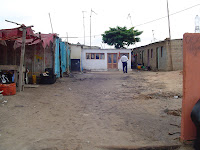Finding a restaurant in Soyo is not easy. There are many, but they don't advertise themselves like they do in your typical First World countries. You go by word-of-mouth, and the best way to do that is to speak to the locals. And don't look for name signs either, the closest sign that might indicate that is is a restaurant is a Cuca sign (local beer) against a wall...or a couple of plastic chairs arranged around manky tables. So it is even better if you take the local with you to guide you to the right place.
Today I was invited to join some colleagues for lunch. My local friend looked a bit hesitant to ask me if I wanted to eat at the mess or go with them to a local restaurant. The reason being that there "are just so many flies" and "no air conditioning" at the local restaurant, and he was thinking that I might not want to eat my meal under those conditions. I might also not like the local food he said, which can be divided into local fish or local meat with rice and beans.
(Note* - Now if you ever have the choice between local fish and local meat in a remote African country, it is always better to go for the local fish. Local meat is usually what they call "bush meat", and does not have the stamp of approval from the local Meat Board. So stick with the local fish, the chances that your stomach survives it is much better. But don't dish the bush meat either, it can be good too.)
 I was a bit offended that anyone might think that I prefer an air-conditioned restaurant with white serviettes to a "local restaurant", but I accepted the invitation because there is no better way to learn and experience local cultures than doing it around a table with locals and a local meal being served. The restaurant itself I never would've found if I was searching for it on my own. It does not have a name either, locals refer to it by refering to the owner, which in this case is Mrs Natalia's place. The chairs were made out of plastic and not much decoration on the tables, but the vibe was all African. It was clear to see that there were extentions made to the building recently, and I was told that business was very good and that the restaurant was made bigger to accommodate more guests.
I was a bit offended that anyone might think that I prefer an air-conditioned restaurant with white serviettes to a "local restaurant", but I accepted the invitation because there is no better way to learn and experience local cultures than doing it around a table with locals and a local meal being served. The restaurant itself I never would've found if I was searching for it on my own. It does not have a name either, locals refer to it by refering to the owner, which in this case is Mrs Natalia's place. The chairs were made out of plastic and not much decoration on the tables, but the vibe was all African. It was clear to see that there were extentions made to the building recently, and I was told that business was very good and that the restaurant was made bigger to accommodate more guests.
(Note* - Local restaurants don't take dollars, but changing dollars to local currency is very easy. Wherever you stop you find guys running up to the car with a fistfull of kwansas, ready to exchange. Whether you get a good exchange rate I doubt very much, but my local guide looked at how many notes I was handed in return for my twenty dollars and said that should be close to right. I didn't argue.)
(Note* - Now if you ever have the choice between local fish and local meat in a remote African country, it is always better to go for the local fish. Local meat is usually what they call "bush meat", and does not have the stamp of approval from the local Meat Board. So stick with the local fish, the chances that your stomach survives it is much better. But don't dish the bush meat either, it can be good too.)
(Note* - Local restaurants don't take dollars, but changing dollars to local currency is very easy. Wherever you stop you find guys running up to the car with a fistfull of kwansas, ready to exchange. Whether you get a good exchange rate I doubt very much, but my local guide looked at how many notes I was handed in return for my twenty dollars and said that should be close to right. I didn't argue.)
The bill for the meal plus the Coke came to 600 kwansas, that is about 7 USD. When I got back to the office I did the calculations to see if the exchange rate that I was given was fair, and I have to admit, they did not take me for a ride this time. I was told that when Mrs Natalia does her "piglet" (pork) on a spit, then I must not miss it. So next time I'm here I can ask anyone to take me to Mrs Natalia's place to have some of her favourite "piglet".


No comments:
Post a Comment